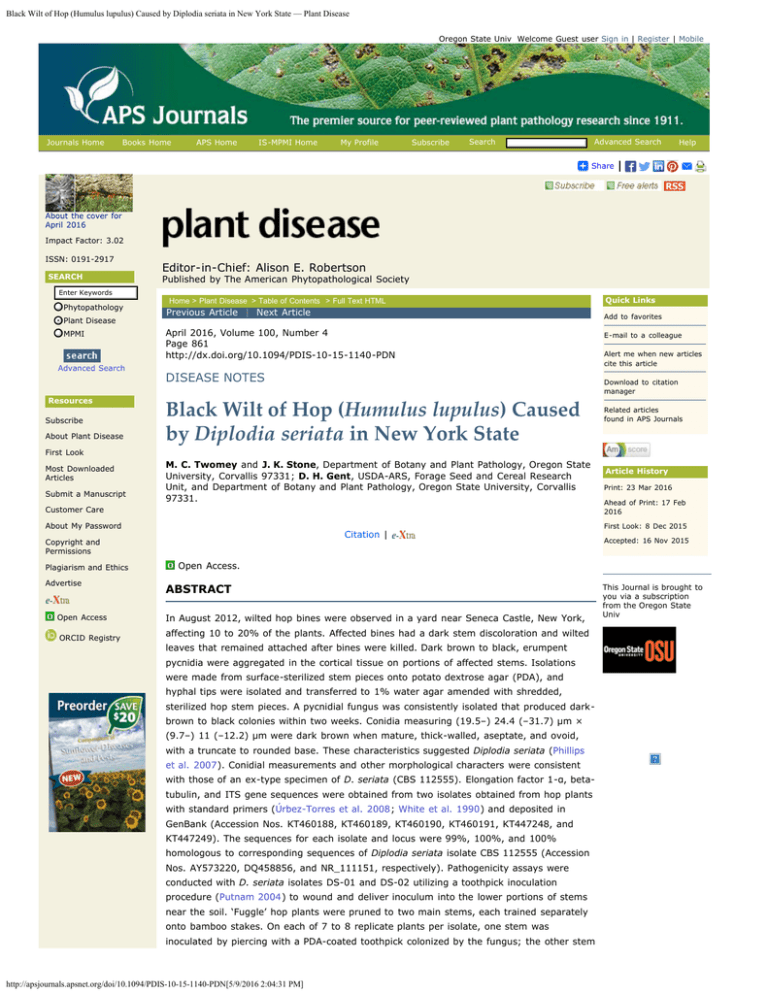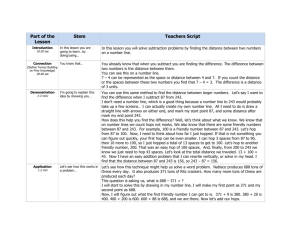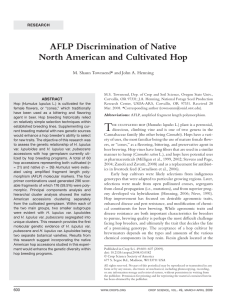Editor-in-Chief: Alison E. Robertson
advertisement

Black Wilt of Hop (Humulus lupulus) Caused by Diplodia seriata in New York State — Plant Disease Oregon State Univ Welcome Guest user Sign in | Register | Mobile Journals Home Books Home APS Home IS-MPMI Home My Profile Subscribe Search Advanced Search Help Share About the cover for April 2016 Impact Factor: 3.02 ISSN: 0191-2917 SEARCH Editor-in-Chief: Alison E. Robertson Published by The American Phytopathological Society Enter Keywords Phytopathology Plant Disease MPMI Advanced Search Resources Subscribe About Plant Disease Quick Links Home > Plant Disease > Table of Contents > Full Text HTML Previous Article | Next Article Add to favorites April 2016, Volume 100, Number 4 Page 861 http://dx.doi.org/10.1094/PDIS-10-15-1140-PDN DISEASE NOTES Black Wilt of Hop (Humulus lupulus) Caused by Diplodia seriata in New York State E-mail to a colleague Alert me when new articles cite this article Download to citation manager Related articles found in APS Journals First Look Most Downloaded Articles Submit a Manuscript M. C. Twomey and J. K. Stone, Department of Botany and Plant Pathology, Oregon State University, Corvallis 97331; D. H. Gent, USDA-ARS, Forage Seed and Cereal Research Unit, and Department of Botany and Plant Pathology, Oregon State University, Corvallis 97331. Customer Care About My Password Citation | Copyright and Permissions Plagiarism and Ethics Advertise Open Access. ABSTRACT Open Access In August 2012, wilted hop bines were observed in a yard near Seneca Castle, New York, ORCID Registry affecting 10 to 20% of the plants. Affected bines had a dark stem discoloration and wilted leaves that remained attached after bines were killed. Dark brown to black, erumpent pycnidia were aggregated in the cortical tissue on portions of affected stems. Isolations were made from surface-sterilized stem pieces onto potato dextrose agar (PDA), and hyphal tips were isolated and transferred to 1% water agar amended with shredded, sterilized hop stem pieces. A pycnidial fungus was consistently isolated that produced darkbrown to black colonies within two weeks. Conidia measuring (19.5–) 24.4 (–31.7) µm × (9.7–) 11 (–12.2) µm were dark brown when mature, thick-walled, aseptate, and ovoid, with a truncate to rounded base. These characteristics suggested Diplodia seriata (Phillips et al. 2007). Conidial measurements and other morphological characters were consistent with those of an ex-type specimen of D. seriata (CBS 112555). Elongation factor 1-α, betatubulin, and ITS gene sequences were obtained from two isolates obtained from hop plants with standard primers (Úrbez-Torres et al. 2008; White et al. 1990) and deposited in GenBank (Accession Nos. KT460188, KT460189, KT460190, KT460191, KT447248, and KT447249). The sequences for each isolate and locus were 99%, 100%, and 100% homologous to corresponding sequences of Diplodia seriata isolate CBS 112555 (Accession Nos. AY573220, DQ458856, and NR_111151, respectively). Pathogenicity assays were conducted with D. seriata isolates DS-01 and DS-02 utilizing a toothpick inoculation procedure (Putnam 2004) to wound and deliver inoculum into the lower portions of stems near the soil. ‘Fuggle’ hop plants were pruned to two main stems, each trained separately onto bamboo stakes. On each of 7 to 8 replicate plants per isolate, one stem was inoculated by piercing with a PDA-coated toothpick colonized by the fungus; the other stem http://apsjournals.apsnet.org/doi/10.1094/PDIS-10-15-1140-PDN[5/9/2016 2:04:31 PM] Article History Print: 23 Mar 2016 Ahead of Print: 17 Feb 2016 First Look: 8 Dec 2015 Accepted: 16 Nov 2015 This Journal is brought to you via a subscription from the Oregon State Univ Black Wilt of Hop (Humulus lupulus) Caused by Diplodia seriata in New York State — Plant Disease was not inoculated. Eight control plants were pierced with a PDA-coated toothpick without the fungus. Plants were kept in a mist chamber for 10 days and then maintained in a greenhouse at 24°C with a 14-h light cycle for 9 months. Twenty-nine percent of plants inoculated with isolate DS-01 and 38% of plants inoculated with DS-02 had stunted growth and wilting, and developed diffuse lesions radiating outward from the inoculation site. The fungus was reisolated from all symptomatic stems and confirmed as D. seriata based on morphological characters and resequencing of the three loci. The pathogen was not recovered from asymptomatic plants or noninoculated controls. To our knowledge, this is the first report of infection of hop by D. seriata in the United States. At present, the disease appears to be only a minor issue on hop in New York State. D. seriata is a common and broadly distributed pathogen on grapevine and other woody hosts. The long incubation period of this fungus may limit symptom development on the annually produced shoots of hop. Section: References: Choose Phillips, A. J., et al. 2007. Fungal Divers. 25:141. [ISI] Putnam, M. L. 2004. Plant Pathol. 53:252. 10.1111/j.0032-0862.2004.00964.x [CrossRef] [ISI] Úrbez-Torres, J. R., et al. 2008. Plant Dis. 92:519. 10.1094/PDIS-92-4-0519 [Abstract] [ISI] White, T. J., et al. 1990. Page 315 in: PCR Protocols: A Guide to Methods and Applications. M. A. Innis, et al., eds. Academic Press, San Diego. [CrossRef] Citation | Journals Home Books Home APS Home IS-MPMI Home http://apsjournals.apsnet.org/doi/10.1094/PDIS-10-15-1140-PDN[5/9/2016 2:04:31 PM] Contact Us Permissions Privacy Copyright The American Phytopathological Society




